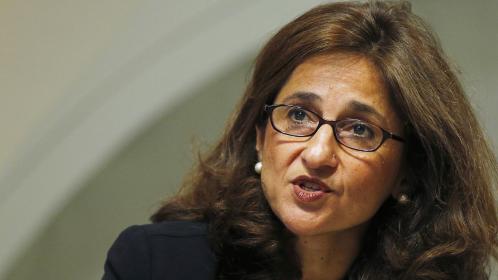
Central banks are trying to squeeze out the last drop
A few days ago it was announced that Dame Minouche Shafik, who joined the Bank of England as one of its deputy governors two years ago, would shortly be leaving.
Her departure — to take up the post of director of the London School of Economics — was perhaps understandable; she described it as an opportunity that was impossible to resist.
It was a reminder, however, of what an extraordinary period we live in as far as the actions of central banks are concerned. When Shafik was appointed in 2014 she was given the role of managing the unwinding of the Bank’s quantitative easing (QE) programme — organising the process by which the £375bn of gilts (UK government bonds) it purchased would be sold back to investors.
At the time, with the effects of the financial crisis fading and the economy growing strongly, reversing QE was firmly on the agenda, as were higher interest rates. In August 2014, the Bank was working with market assumptions that interest rates would be 2% by now.
Things have turned out differently. The Bank, rather than running down QE, has just announced £60bn more of it, together with £10bn of corporate bond purchases. Interest rates have been cut to 0.25%, with the Bank’s latest minutes saying most members of the monetary policy committee (MPC) are minded to cut further, to just above zero (0.05% or 0.1%) later in the year. It should be said that one MPC member, Kristin Forbes, says she is not yet convinced of the need for a further cut.
When will the Bank’s QE be reversed? Will it ever be? Given it has just cut interest rates and may do so again, and launched another QE round, any reversal is years away. The Bank, as it said last November, will not even contemplate a back-door reversal of QE — not reinvesting the proceeds of maturing gilts it has in its portfolio — until interest rates hit 2%. That suggests a timetable stretching well beyond Mark Carney’s stint as Bank governor, due to end in mid-2018, though no doubt to the horror of some headbanger Brexiteers he may stay on until 2021.
Shafik could pursue a successful LSE career and come back to the Bank in time to administer the QE reversal; not that I think she will. The Bank, of course, was responding to Brexit, without which it is very unlikely there would have been an interest rate cut or more QE. But it is part of a wider phenomenon in which central banks, after years of near-zero interest rates, are still attempting to squeeze the last drop out of monetary policy.
Last week saw two interesting announcements from the big central banks. The Federal Reserve in America came closer than it has for a while to an increase in interest rates, with a 7-3 vote for no change. The fact remains, however, that last December’s token quarter-point rise in rates, intended to be the first in a regular sequence, still stands alone.
By now, according to the guidance then, we would have had the third of four 2016 Fed rate rises. We have yet to have any. And while Janet Yellen, the Fed chairwoman, says markets should expect a rate rise at its December meeting, there is many a slip ’twixt cup and lip, not least the uncertainty that would follow a Donald Trump election victory in November.
More interesting was the Bank of Japan (BoJ). It has already adopted negative interest rates and expanded QE at a faster rate than other major economies. The BoJ is in the forefront of “Abenomics”, the effort by Japan’s prime minister Shinzo Abe to shake Japan out of its torpor.
Ahead of last week’s meeting, some expected the BoJ to announce even more negative interest rates and expand its already large QE programme. In the event it did something slightly different. It announced it would continue with QE until Japan’s inflation rate, currently -0.4%, is both positive and above 2%. It will keep pumping money in, in other words, until deflation — a falling price level — has been comfortably eliminated.
Even more interesting was that it set a target for the yield — the interest rate — on 10-year government bonds. The BoJ will aim to keep that yield at exactly zero indefinitely, implying that the Japanese government will be able to undertake its borrowing, or at least its 10-year borrowing, free of charge.
What should we make of all this? Ben Bernanke, former Fed chairman, earned the nickname “Helicopter Ben” for a 2002 speech outlining the mechanics of a so-called helicopter drop of money.
Helicopter money has its advocates, including Lord (Adair) Turner, the former Financial Services Authority chairman who now chairs the Institute for New Economic Thinking. It takes many forms, ranging from the central banks creating money to hand out to households to what is known as monetary finance.
Monetary finance is a bit like QE without safeguards. Central banks create money to fund the budget deficit, without governments having to issue new bonds. As Bernanke has put it, using the example of the US, “the Fed credits the Treasury with $100bn in the Treasury’s ‘checking account’ at the central bank”, with the funds used for boosting spending or tax cuts. Governments can expand deficits without going near the markets. Monetary and fiscal policy go hand in hand.
Many people, myself included, regard this with concern. Where would it end, if not with irreversible reputational damage for the central bank and the prospect of significantly higher inflation in future? And while we may trust our current politicians to be responsible, once the rubicon is crossed, what would stop future politicians taking enormous liberties with the public finances? The discipline of the market is quite a useful one to have.
Central bankers seem to agree. Haruhiko Kuroda, BoJ governor, has spoken out against helicopter money. Carney said last month: “I can’t conceive of a situation in which there would be a need to have such flights of fancy here in the UK.”
The question is whether central banks are drifting into helicopter money by default. Bernanke, analysing the BoJ’s announcements for the Brookings Institution, wrote “a policy of keeping the government’s borrowing rate at zero indefinitely has some elements of monetary finance”.
In the case of the Bank of England, there is a finer line than Carney would like between helicopter money and a QE programme that may not begin to be reversed until the 2020s, if then. Its effect has been to reduce the government’s cost of borrowing — to zero in the case of the gilts bought by the Bank — and make it easier to run large budget deficits, something the new chancellor may be glad of. Monetary and fiscal policy have overlapped. The helicopters have not yet taken off but there are a few drones already buzzing around.
PS A surprising number of people have asked me about my skip index. As long-suffering readers will know, it is based on the number of builders’ skips in my street, with none indicating zero growth or recession, two normal or “trend” growth, and four an unsustainable boom.
So what’s been happening? The index was reasonably healthy until the spring, when it fell to zero in the run-up to the referendum, and now stands at one. In other words, there’s growth but not much of it.
How does that fit more conventional evidence? Quite well. There has been much gloating at the OECD’s expense for modestly revising up its 2016 growth forecast, having warned of an immediate Brexit hit. But the OECD was largely responding to stronger pre-referendum numbers: the 0.6% rise in gross domestic product in the second quarter, owing much to a surprisingly strong bounce in activity as long ago as April. Maybe there was a collective clearing of decks back then. The National Institute of Economic and Social Research, which estimates monthly GDP numbers, says the broad picture is flat, with GDP last month the same as in April. The economy isn’t skipping along, but it could have been worse.






